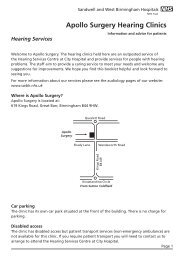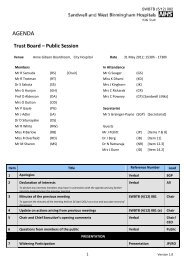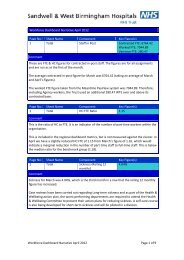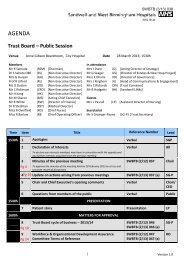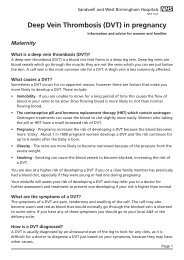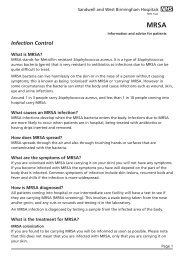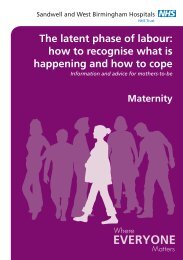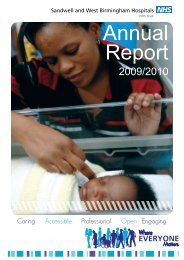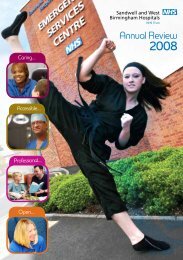January 2012 - Sandwell & West Birmingham Hospitals
January 2012 - Sandwell & West Birmingham Hospitals
January 2012 - Sandwell & West Birmingham Hospitals
You also want an ePaper? Increase the reach of your titles
YUMPU automatically turns print PDFs into web optimized ePapers that Google loves.
SWBTB (1/12) 286 (a)<br />
The Department of Health guidelines require that proposals for significant reconfigurations<br />
are subject to initial clinical assurance by the National Clinical Advisory Team (NCAT). In line<br />
with this requirement a visit by NCAT took place in <strong>January</strong> <strong>2012</strong> and whilst we have yet to<br />
receive their written report, their verbal feedback endorsed the clinical case for change and<br />
the need to consolidate acute stroke and TIA services on one site. They strongly supported<br />
the direction of travel and if anything were surprised these changes had not already been<br />
made. NCAT felt both of the short listed service models were appropriate.<br />
Options<br />
The Project Board and Steering Group through several staff engagement events developed a<br />
long list of options along with a set of evaluation criteria and a short listing process. Using the<br />
agreed evaluation criteria and weighting the long list of 6 options were scored by 3<br />
stakeholder groups: –<br />
1. Local patients and carers who are stroke and TIA experts by experience<br />
2. Stroke Reconfiguration Project Steering Group<br />
3. Clinical staff from all relevant professions working in stroke and TIA services at SWBH<br />
at a ‘Listening into Action’ event.<br />
GPs have subsequently been engaged by the project team on a one to one basis with<br />
representation across the relevant <strong>Sandwell</strong> and <strong>West</strong> <strong>Birmingham</strong> Clinical Commissioning<br />
Group (SWBCCG) to discuss the proposed short list and the process. All the individual GPs<br />
consulted were satisfied with the process that had been undertaken and stated preferences<br />
for the short listed options. The Project Board then identified the two options with the highest<br />
scores as the short list. These are:<br />
Option 3: A single site model with all inpatient (acute and rehabilitation) stroke, Neurology<br />
and TIA facilities and services located at one Hospital.<br />
Option 6: A two site model with one hyper-acute stroke unit, acut Neurology inpatients and<br />
high risk TIA services located at one Hospital. Rehabilitation services would be provided at<br />
both City and <strong>Sandwell</strong> <strong>Hospitals</strong>.<br />
At this stage no clear clinical reasons had been identified to suggest which of the City and<br />
<strong>Sandwell</strong> Hospital sites the acute services should be located on. Subsequently a high level<br />
scoping analysis has been undertaken around the areas of activity, capacity, facilities, staffing<br />
and finance. Whilst the Trust is currently engaged in discussions with commissioners on the<br />
overall funding settlement for services in 12/13, the findings from this work confirm that the<br />
impact associated with the short listed options are within the boundaries of what would<br />
normally be affordable to the health economy taking account of capacity and feasibility and<br />
that the variations between placing the acute services on either City or <strong>Sandwell</strong> Hospital are<br />
not significant enough to discount either site at this stage. As a result it is proposed that each<br />
or the short listed options has two variant options with one locating acute services at the City<br />
site and the other at the <strong>Sandwell</strong> site giving four short listed options for consultation. It is<br />
important to recognise however, that further, more detailed work will need to be undertaken in<br />
each of these areas, for each of the short listed options with the findings being fed into the<br />
decision making process that will be undertaken at the end of consultation, to determine a<br />
preferred option. It should also be noted that at this stage all options appear likely to require<br />
some capital investment.<br />
It was agreed that the options of Do Nothing and retain the current configuration but introduce<br />
new ways of working for medical teams in order to provide acceptable levels of cover at all<br />
times would not be scored as they did not meet the clinical drivers for change in terms of<br />
consolidating acute stroke and TIA services in order to provide the critical mass of expertise<br />
and skills that could meet the standards in a consistent was and deliver improved clinical<br />
outcomes. They will however need to be included in the next stage of detailed financial<br />
2




